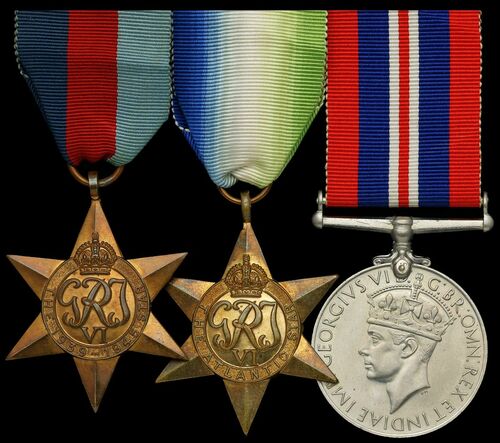
Auction: 23112 - Orders, Decorations and Medals - e-Auction
Lot: 596
A documented Second World War campaign group of three awarded to Able Seaman Thomas Harris, Royal Navy
Actively employed in the cruiser H.M.S. Glasgow, he shared in her honours at the Battle of the Bay of Biscay in December 1943, when she contributed to the remarkable 'whipping' of eleven German destroyers, three of them fatally so
So, too, in Glasgow's truculent part in the three-hour bombardment of Cherbourg in late June 1944, when, under heavy fire from the enemy's batteries, she 'turned straight in towards the shore as if she would crash right into the harbour' and swiftly received two heavy calibre hits
1939-45 Star; Atlantic Star; War Medal 1939-45, good very fine (3)
Thomas Harris was born in Peckham, London on 7 February 1912 and entered the Royal Navy as an Ordinary Seaman in June 1943.
Having completed his basic training, he joined the light cruiser H.M.S. Glasgow in September 1943, and he remained likewise employed until December 1945, thereby witnessing extensive action, not least in what became known as the Battle of the Bay of Biscay.
The Battle of the Bay of Biscay, 28 December 1943
On that occasion, in the company of her 'good companion' the Enterprise, Glasgow fought a remarkable action against five Narvik- and six Elbing-class enemy destroyers.
It was far from a one-sided encounter, the British total armament amounting to nineteen 6-inch guns, versus a German one of no less than forty-nine 5.9-inch or 4.1-inch guns, and a superiority of 76 torpedo tubes to just fourteen.
Gordon Holman's The King's Cruisers takes up the story:
'Our aircraft continued to shadow the enemy ships until the Glasgow and Enterprise came in sight of them early in the afternoon. At long range, both cruisers opened fire and the enemy quickly replied. For an hour there was a running fight as the opposing ships steamed hard on a south-easterly course. A number of hits were obtained on the destroyers, and, with our aircraft joining in, the Germans split up, first into two or three groups and then into smaller units, as they tried to escape. Although thus meant that some were bound to get away, it was also fatal for those on which the cruisers decided to concentrate. Smoke screens and their extra speed failed to save them, and three of the destroyers were sunk, while others only escaped after receiving damage.'
Holman continues:
'The British cruisers suffered slight damage and a few casualties but, coming within a day or two of the destruction of the Scharnhorst, their success enables the Royal Navy to conclude 1943 on a note of triumph.'
Further honours
In the following year, Glasgow saw further action off the Normandy coast, providing supporting fire to the American landings on Omaha beach on D-Day.
So, too, at the bombardment of Cherbourg, when she went into action alongside her consort Encounter, and cruisers of the United States Navy, the whole under the command of Rear-Admiral Morton L. Depp, U.S.N., flying his flag in the Tuscaloosa.
On that memorable occasion, on 25 June 1944, the allied squadron came under heavy fire from the shore batteries. Gordon Holman's The King's Cruisers, takes up the story:
'Their fire was immediately answered by the big ships, the Glasgow being among the first to get off a salvo. Her 6-inch guns kept up a rapid fire throughout the three hours of the bombardment, and there were times when the Germans seemed to have been stung into concentrating on the British ship. She was twice hit by heavy shells, and although ordered to retire, reported in a quarter of an hour that she was fit to carry on … with her big battle ensign strung out in the breeze, no ship looked, or was, more truculent than the Glasgow. On one occasion she turned straight in towards the shore as if she would crash right into the harbour. Then she reduced speed until she was almost stopped, but despite these deceptive tactics the radar-controlled fire of the enemy hung on to her … '
Harris came ashore at the end of 1945 and was released 'Class A' in March 1946.
Sold with his original Certificate of Service and a picture post card of his intake at Collingwood in early 1943, together with his plated cigarette case, with gilt interior.
Subject to 20% VAT on Buyer’s Premium. For more information please view Terms and Conditions for Buyers.
Sold for
£60
Starting price
£60




